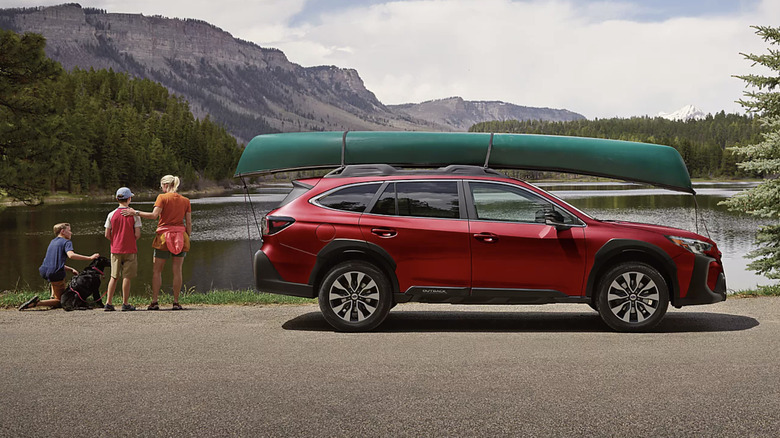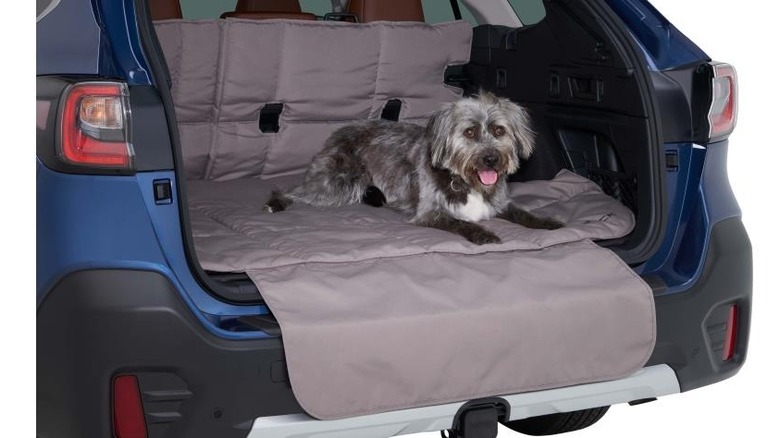5 Things To Know Before Buying A Subaru Outback (New Or Used)
Subaru was launched in 1915 as Fuji Heavy Industries, an aircraft research company. During World War II, the company manufactured planes for the Japanese war effort, and the post-war years brought a shift to the automaking industry and the birth of the Subaru brand. Among Subaru's early efforts was the 360, a Kei car it brought to the United States in 1968. It was slow and unsafe and almost ruined Subaru's reputation stateside.
Some of the cars Subaru has produced were a little weird, but the company has built a footing in the United States over the decades since it brought the flimsy, underpowered 360 here. Subaru's current lineup includes a handful of models that occupy the crossover/station wagon segment, including the popular Outback. This model began as a trim level of the Legacy wagon in 1995 and grew taller and more rugged in its first generation. For the second generation that debuted in 2000, Subaru gave the Outback its own badge, and it's remained a staple in Subaru's lineup since then. If you're considering a brand new or older specimen of these popular go-anywhere wagons, here are some things to keep in mind.
The 2025 Outback comes in 9 trim levels
The 2025 Outback is now available on dealership lots and comes in nine different trim levels. The base model starts at $28,895, and the top-of-the-line Touring XT version starts at $42,795. In Wilderness trim — a version we last reviewed in 2022 — the Outback has a base price of $39,960. That's the same as the Onyx Edition XT. Rounding out the Outback lineup are the Premium at $31,195, the Onyx Edition at $36,105, the Limited at $37,855, the Touring at $40,345, and the Limited XT at $40,195.
The Base, Limited, Onyx, Premium, and Touring editions of the 2025 Outback come with a naturally aspirated 2.5-liter Boxer four-cylinder engine, and the upper four trim levels come standard with a turbocharged 2.5-liter inline four instead. The 2.5-liter engine delivers 182 horsepower and 176 pound-feet of torque, while the slightly smaller turbocharged powerplant puts out 260 horsepower and 277 pound-feet of torque. All Outbacks send that power to all four wheels by way of a continuously variable transmission, so you'll have to hunt down an older model if you want to row your own gears or feel an automatic transmission shifting underneath your feet. Current model year Outbacks come standard with goodies like Traction Control, Hill Descent Control, and Vehicle Dynamics Control, Subaru's electronic stability control suite; these are all features you won't find on most previous versions of the Outback.
It has a reputation for reliability and durability
Older Outbacks are indeed plentiful on the used marketplace, thanks to their tendency to last a long time. There are more than 23,000 used Outbacks for sale on Cars.com alone, including dozens with over 200,000 miles on the odometer. Subaru owners tend to report a high level of satisfaction with their cars, leading to strong brand loyalty. This year, JD Power's annual survey of mass-market brand SUV owners ranked Subaru's 62.6% loyalty rate second only to Honda. Subaru finished atop JD Power's loyalty rankings for all automakers every year from 2019 through 2021, earning a rating of 61.8% in that last year.
Subaru is as confident in its cars as most of its customers. All new Subarus are covered by a three-year, 36,000-mile bumper-to-bumper warranty that extends to five years and 60,000 miles on powertrain components. Owners of Subarus made after 2000 also enjoy free roadside assistance, which includes towing to the nearest Subaru dealer for service.
Head gasket failure is a problem on older Outbacks
Older Subarus aren't entirely without design faults that can lead to trouble, though. Earlier models were notorious for developing head gasket leaks, so if you're looking at older Outbacks, you'll want to know if the head gasket has been replaced by a previous owner. Head gasket leaks were a common problem in Subarus with 2.2 and 2.5-liter engines through the 2011 model year, after which Subaru upgraded the gasket.
If you're looking at an Outback from 2011 or earlier, check the oil dipstick for signs of coolant and look in the radiator and coolant reservoir for any indication of oil intrusion. You should also look around the cylinder head mating surfaces for signs of leaking oil or coolant, and if the seller allows, drain the oil and coolant to get a better look at these fluids. As always, it's best to have a mechanic look over any potential used car purchase, and obtaining a used car history report from Carfax or a similar service might tell you that the gasket has already been replaced.
Outbacks have excellent safety ratings
If you manage to find an Outback with a new head gasket, you can also take comfort in knowing that you will be driving a car that consistently earns favorable crash test ratings from the Insurance Institute for Highway Safety. The 2024 Outback was one of five Subaru models named an IIHS Top Safety Pick, and it earned "Good" ratings in all but one of the agency's benchmarks. The only "Poor" ratings for previous models of the Outback stretching back to 2005 were for the headlights on some trim levels of 2016 and 2017 models, and for most years the Outback got an unbroken string of green "good" marks.
The National Highway Traffic Safety Administration conducts its own vehicle tests, and the 2025 Outback earned five out of five stars from that agency for overall, frontal, and side impact testing as well as four out of five in rollover crash tests. That's consistent with results for prior model year Outbacks, most of which earned the same scores as the current model.
Dog-owning families will love the Outback
The Outback found its way onto SlashGear's list of the most dog-friendly vehicles you can buy, thanks to a handful of Fido-friendly features. It has easy-to-clean upholstery for when paws get muddy, and each of its nine trim levels offers a generous 32.6 cubic feet of cargo space with the rear seats folded up. Lay them flat, and that more than doubles to 75.6 cubic feet, giving you enough room for a couple of crates and bags of food. Subaru also sells a collection of dog accessories for the Outback, from harnesses and water/food bowls to a bumper protector, a combination bed and carrier, and a ramp for older dogs. There are seat, door, and cargo bed protectors to keep hair and slobber contained, and Subaru even markets its cars as dog-friendly with a series of TV ads.
Subaru extends its obvious love of dogs to corporate actions beyond design and manufacturing. Each October, the automaker partners with the American Society for the Prevention of Cruelty to Animals and local rescue organizations to hold pet adoption events, and the organization has credited Subaru's involvement with helping improve the welfare of more than half a million shelter animals.





